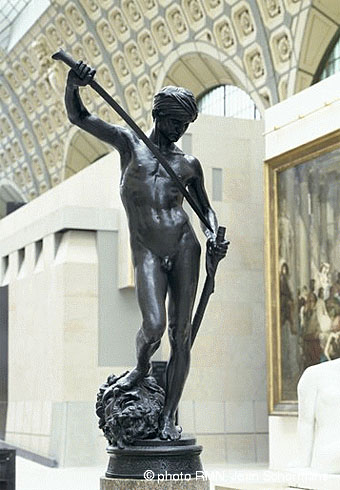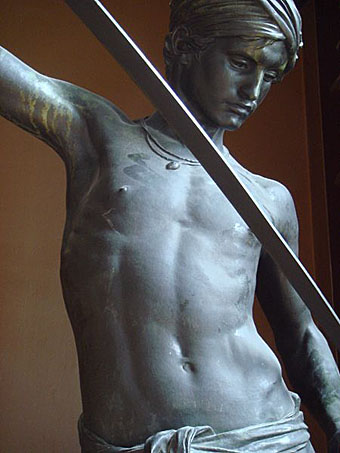David (c.1872).
I’d marked out this statue as a suitable addition to the burgeoning men with swords archive some time ago but it took the discovery of a piece of writing to prompt this post. Antonin Mercié’s statue of David resides today in the Musée d’Orsay, Paris, but I managed to miss it on my visit there. Judging by the photos it’s situated at the end of the main hall near Rodin’s enormous Gates of Hell, and it was the Rodin which claimed my attention that day. It’s also the case that the D’Orsay hall (formerly a railway station) is such a cavernous space that free-standing works such as this lose their impact, they’d look far better in smaller rooms.
At the late 1870s, Antonin Mercié incarnated the young generation of French sculptors who, without breaking away from the traditional canons, wanted to make their figures more vibrant. He sought to combine the skilled composition and lively modelling seen in the great models of the Florentine Renaissance: hence the sweeping curves of the arm extended by the movement of the sword, the bent knee, and the graceful movement of this David. A spectator walking round it can appreciate the way the planes gradually modulate the space. Mercié carved himself an original path between modern classicism and explicit realism. (More.)
You tend to find with many nude sculptures of the 19th century that the original is the naked one while the copies have gained additional items of clothing. This is the case with Mercié’s David whose replicas like the one above from the University of Copenhagen has a wrap around his waist. It’s the nude condition of the Paris statue that lends a frisson to a piece of writing by French author Patrick Drevet which may be fiction or may be reportage. An Angel at Orsay describes an elaborate game of homoerotic voyeurism as the narrator wanders through the museum and stops by Mercié’s David when he spots a student boy sketching the statue. Drevet’s piece is a sustained reverie inspired by his act of studying the student who studies the statue in turn and then becomes engaged by another student boy, the latter deliberately placing himself on view gazing at the statue and hoping (so the narrator surmises) to be sketched himself. A meagre précis like this fails to do Drevet’s piece any justice, it really needs to be read in its entirety. I found it in the Penguin Book of International Gay Writing (1995), and it may well be available in a collection of the author’s work. It’s certainly enough to make me want to read more of Drevet’s writing.
Elsewhere on { feuilleton }
• The men with swords archive
Previously on { feuilleton }
• Behold the (naked) man



Facially maybe not quite as much, and David himself probably would have been a bit more modestly clothed, however the sash and the sword have a far more authentically semitic look about them than most biblical depictions by Europeans. This has always annoyed me. As great in other areas as they were, the Italian Rennaisance painters were often the worst in this regard, portraying ancient Middle Easterners as blonde male strippers whose little clothing usually consisted of Western-styled armor. Especially discraceful when one remembers that in their Roman days, Italy and her subject states were more connected to the greater Mediterrenean/Africa/Asia Minor than they were to the rest of Europe.
I would have written a bit more about this if my internet service hadn’t collapsed for a whole evening.
You’re right, this David is part of that trend in 19th century art for greater verisimilitude. It could also been seen as a riposte to Donatello’s famous (and famously effete) David who looks barely capable of lifting his sword, never mind slaying a giant. Some artists such as William Holman Hunt insisted on travelling to Palestine in order to paint their Bible scenes. Those who didn’t at least had a better idea of what the Middle East was like from photographs and archaeological studies. Renaissance scuplture, when it’s not copying the Greeks, is rather like the unrealistic Wild West in movies of the 1950s, where everyone has Brylcreem quiffs, smooth chins, a full set of teeth and clean clothes.
Yes indeed, a lot of these stupid polished cowboy hat-wearing idealists where I live (some of whom may resemble to you a certain well-known American who isn’t as prominent anymore but did piss a lot of people off) despise shows like Deadwood and the Sergio Leone westerns saying shit like, “they’re so vulgar and pessimistic.”
Well honestly, how the fuck do you think it was really like living in the Wild West? Do you think they all drove Chevies and listened to god-awful contemporary country music and went to cowboy, pardon me, wannabe cowboy clubs?